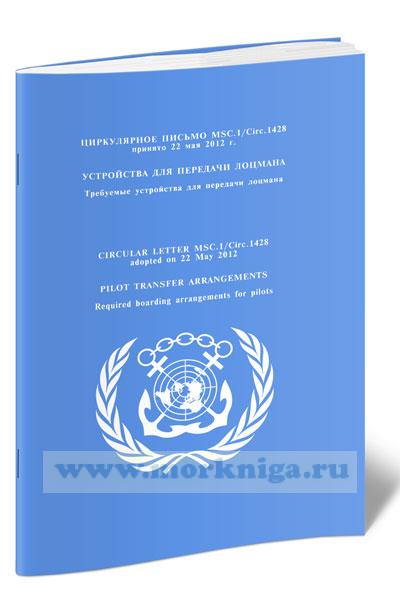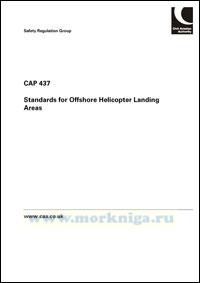Сб с 10 до 16
CAP 437. Standards for Offshore Helicopter Landing Areas
-
 Циркулярное письмо MSC.1.Circ.1428 Устройства для передачи лоцмана
Циркулярное письмо MSC.1.Circ.1428 Устройства для передачи лоцмана
-
 Циркулярное письмо MSC.1/Circ.1304 Руководство по применению правила III/7 конвенции СОЛАС с поправками в резолюции MSC.201(81)
Циркулярное письмо MSC.1/Circ.1304 Руководство по применению правила III/7 конвенции СОЛАС с поправками в резолюции MSC.201(81)
-
 Перечень резолюций сессий ассамблей и других важнейших решений ИМО. Шестое издание, исправленное и дополненное (по состоянию на август 2006 г.)
Перечень резолюций сессий ассамблей и других важнейших решений ИМО. Шестое издание, исправленное и дополненное (по состоянию на август 2006 г.)
This publication, re-named Standards for Offshore Helicopter Landing Areas, has become an accepted world-wide source of reference. The amendments made to the seventh edition incorporate final results of valuable experience gained from the CAA- funded research project conducted with the support of the UK offshore industry and the UK Health and Safety Executive (HSE) into improved helideck lighting systems. In particular a final specification for the Touchdown/Positioning Marking (TD/PM) Circle and Heliport Identification ('H') Marking lighting system is presented in Appendix C, and referenced from Section 3 in Chapter 4. As a consequence of the introduction to service of new lighting systems, which the CAA - with the support of the Helicopter Task Group (established by Oil and Gas UK (OGUK)) - is recommending should be implemented on all existing and new-build installations operating on the UK Continental Shelf (UKCS), previous references to the use of deck-mounted floodlighting systems as an aid to landing have been relegated to Appendix material (see Appendix G). The CAA believes that the new lighting scheme fully described in the seventh edition represents a significant safety enhancement over traditional floodlighting and will take every opportunity to actively encourage the industry to deploy the new lighting scheme in preference to floodlighting. The TD/PM Circle and Heliport Identification ('H') Marking lighting forms an acceptable alternative to floodlights in International Civil Aviation Organization (ICAO) Annex 14 Volume II.
Contents
List of Effective Pages Revision History Foreword
Glossary of Terms and Abbreviations
Chapter 1 Introduction
History of Development of Criteria for Offshore Helicopter Landing Areas, 1964-1973
Department of Energy and the Health and Safety Executive Guidance on the Design and Construction of Offshore Installations, 1973 Onwards
Applicability of Standards in Other Cases
Worldwide Application
Chapter 2 Helicopter Performance Considerations
General Considerations Safety Philosophy
Factors Affecting Performance Capability Chapter 3 Helicopter Landing Areas - Physical Characteristics
General
Helideck Design Considerations - Environmental Effects
Structural Design
Loads - Helicopters Landing
Loads - Helicopters at Rest
Size and Obstacle Protected Surfaces
Surface
Helicopter Tie-Down Points
Perimeter Safety Net
Access Points
Winching (Hoist) Operations
Normally Unattended Installations (NUIs)
Chapter 4 Visual Aids
General
Helideck Landing Area Markings Lighting
Obstacles - Marking and Lighting Chapter 5 Helideck Rescue and Fire Fighting Facilities
Introduction
Key Design Characteristics - Principal Agent
Use and Maintenance of Foam Equipment
Complementary Media
Normally Unattended Installations
The Management of Extinguishing Media Stocks
Rescue Equipment
Personnel Levels
Personal Protective Equipment (PPE)
Training
Emergency Procedures Further Advice
Chapter 6 Helicopter Landing Areas - Miscellaneous Operational Standards
Landing Area Height above Water Level Wind Direction (Vessels)
Helideck Movement Meteorological Information
Location in Respect to Other Landing Areas in the Vicinity Control of Crane Movement in the Vicinity of Landing Areas General Precautions
Installation/Vessel Helideck Operations Manual and General Requirements
Helicopter Operations Support Equipment
Chapter 7 Helicopter Fuelling Facilities - Systems Design and Construction
General
Product Identification Fuelling System Description
Chapter 8 Helicopter Fuelling Facilities - Maintenance and Fuelling Procedures
General
Fuel Quality Sampling and Sample Retention
Recommended Maintenance Schedules
Filling of Transit Tanks
Receipt of Transit Tanks Offshore
Decanting from Transit Tanks to Static Storage
Fuelling Direct from Transit Tanks
Long Term Storage of Aviation Fuel
Aircraft Refuelling
Quality Control Documentation
Chapter 9 Helicopter Landing Areas on Vessels
Vessels Supporting Offshore Mineral Workings and Specific Standards for Landing Areas on Merchant Vessels
Amidships Helicopter Landing Areas - Purpose-Built or Non-Purpose-Built Ship's Centreline
Helicopter Landing Area Marking and Lighting
Ship's Side Non-Purpose-Built Landing Area
Ship's Side Non-Purpose-Built Landing Area Markings
Night Operations
Poop Deck Operations
Chapter 10 Helicopter Winching Areas on Vessels and on Wind
Turbine Platforms
Winching Areas on Vessels
Helicopter Winching Areas on Wind Turbine Platforms
Appendix A Checklist
Appendix B Bibliography
References
Sources
Appendix C Specification for Helideck Lighting Scheme
Comprising: Perimeter Lights, Lit Touchdown/ Positioning Marking and Lit Heliport Identification Marking
Overall Operational Requirement 1
Definitions 2
The Perimeter Light Requirement 2
The Touchdown/Positioning Marking Circle Requirement 3
The Heliport Identification Marking Requirement 6
Other Considerations 8
Appendix D Helideck Fire-Fighting Provisions for Existing
Normally Unattended Installation (NUI) Assets on the United Kingdom Continental Shelf
Appendix E Additional Guidance Relating to the Provision of Meteorological Information from Offshore Installations
Introduction 1
Contents and Standardisation of the Weather Reports Issued by Each Offshore Installation
Example Offshore Report
Definition of an Offshore Meteorological Observer
Applicability of Meteorological Equipment to Helideck Categories
Design, Siting and Back-up Requirements for Meteorological Equipment Installed in Offshore Installations
Calibration, Maintenance and Servicing Periods
Appendix F Procedure for Authorising Offshore Helicopter Landing Areas
Appendix G Guidance for Helideck Floodlighting Systems
Introduction
General Considerations for Helideck Floodlighting
Improved Floodlighting System (an extract from the CAA's letter to industry dated 9 March 2006)
